Multiple Choice
The following questions refer to the description and Figure 23.1.
Figure 23.1 represents a cross section of the sea floor through a mid-ocean rift valley, with alternating patches of black and white indicating sea floor with reversed magnetic polarities. At the arrow labeled "I" (the rift valley) , the igneous rock of the sea floor is so young that it can be accurately dated using carbon-14 dating. At the arrow labeled "III," however, the igneous rock is about 1 million years old, and potassium-40 dating is typically used to date such rocks. Note: The horizontal arrows indicate the direction of sea-floor spreading, away from the rift valley.
 Figure 23.1
Figure 23.1
-If a particular marine organism is fossilized in the sediments immediately overlying the igneous rock at the arrow labeled "II," at which other location(s) , labeled A-E, would a search be most likely to find more fossils of this organism?
A) B only
B) C only
C) D only
D) B and C
E) C and D
Correct Answer:

Verified
Correct Answer:
Verified
Q3: The following questions refer to this hypothetical
Q6: A genetic change that caused a certain
Q7: The loss of ventral spines by modern
Q7: A swim bladder is a gas-filled sac
Q8: The following questions refer to this hypothetical
Q9: Which factor most likely caused animals and
Q17: If the half-life of carbon-14 is about
Q28: <img src="https://d2lvgg3v3hfg70.cloudfront.net/TB7910/.jpg" alt=" Figure 23.1 -Assuming
Q41: The following questions refer to the description
Q60: Bagworm moth caterpillars feed on evergreens and